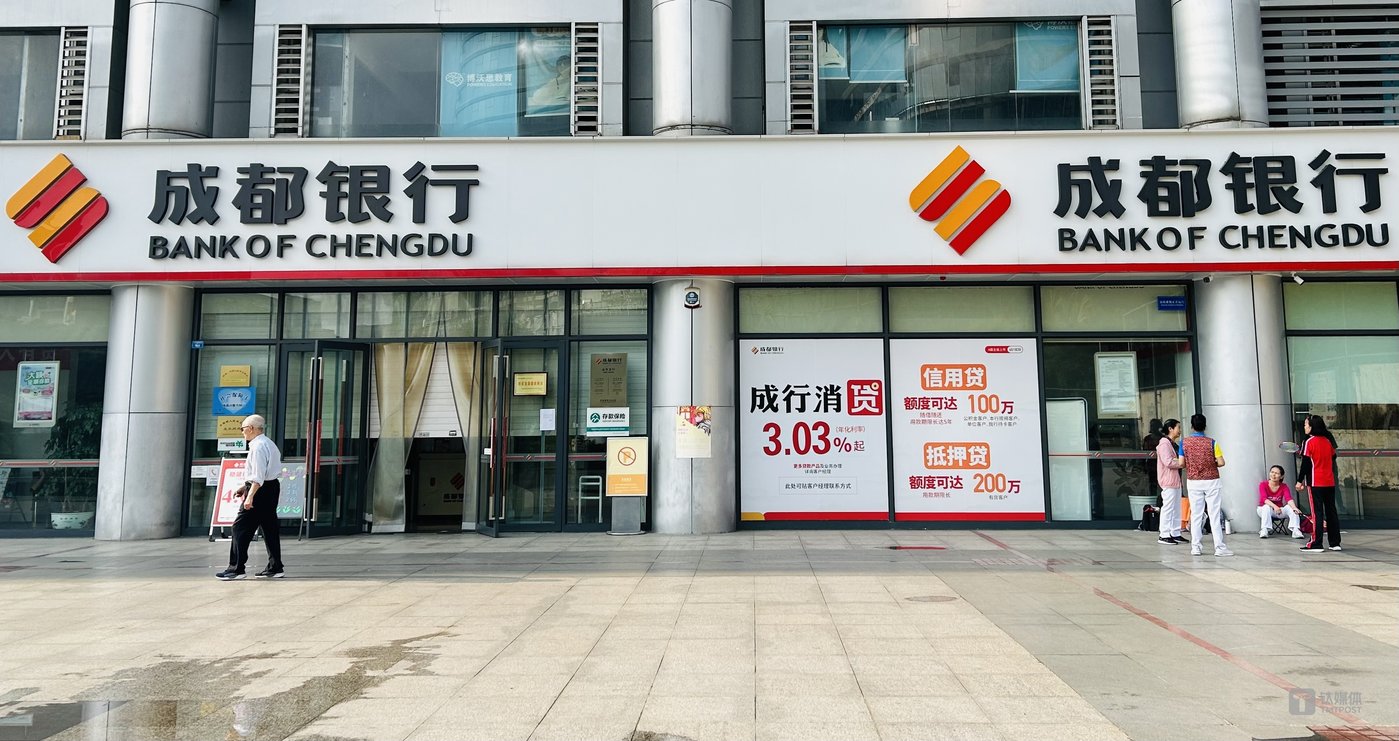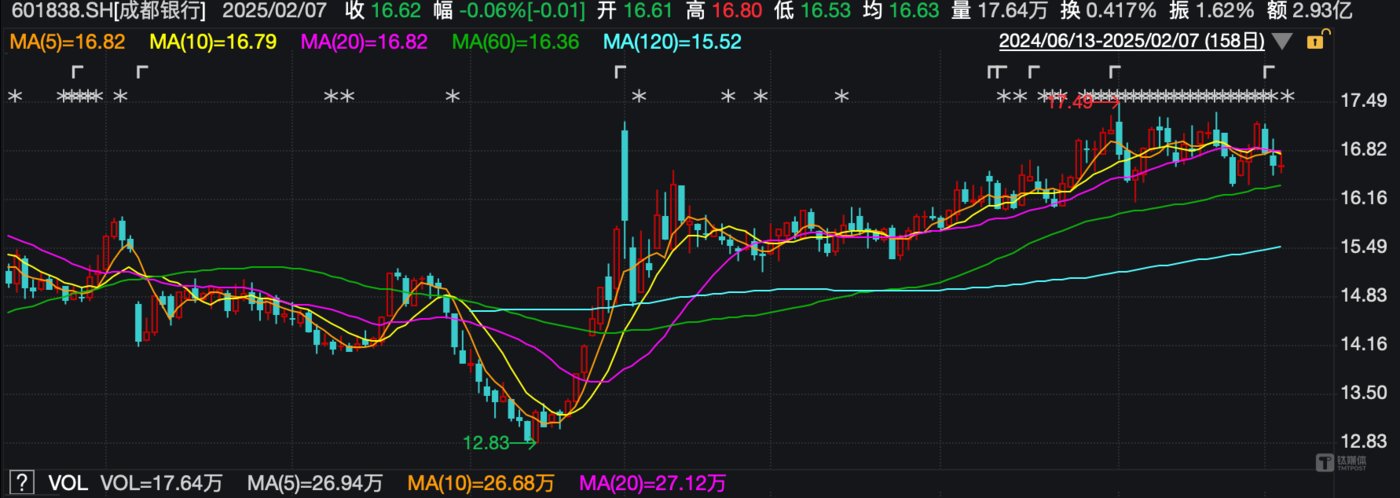
(Source: GuShiio.com Stock Market Smart APP Photo taken)
On the evening of February 6,Chengdu bank(601838.SH) issued an announcement stating that the CCB convertible bonds were officially delisted from the Shanghai Stock Exchange on the same day. So far, Bank of Chengdu has become the first bank in the central and western regions to realize forced redemption of convertible bonds to replenish capital. It is also the first bank to issue convertible bonds in the past five years to complete forced redemption and equity swaps.
In recent years, issuing convertible bonds and seeking to convert shares has become an important way for listed banks to replenish core capital. However, due to the low valuation of bank stocks, it is difficult for banks to convert bonds to achieve overall conversion. Bank of Chengdu completed the process of forced redemption and conversion of convertible bonds ahead of schedule. On the one hand, it benefited from the recovery of the market since the second half of last year, and on the other hand, it was more due to the bank’s high growth in recent years.
8 billion yuan in convertible bonds completedForced redemption and equity swap
According to the announcement, on March 3, 2022, Bank of Chengdu issued 8 billion yuan of convertible bonds, with a shareholder subscription ratio of 79.11%, and obtained 7,144.29 times online subscription. The online winning rate was 0.01399%, creating the best level of convertible bond issuance by domestic listed banks.
On April 6, 2022, the Bank of China Convertible Bonds were listed and traded on the Shanghai Stock Exchange with the securities trading code 113055. Since then, after three cash dividends and ex-dividends, the conversion price of Chengzhou-Silver Convertible Bonds in 2024 was adjusted to 12.23 yuan/share.
In September 2024, the activity of the A-share market increased significantly, and the share price of Bank of Chengdu also climbed. On December 17 of the same year, Bank of Chengdu issued an announcement stating that since November 7, the closing price of 15 trading days has been no less than 1.3 times the current conversion price of Chengyin Convertible Bonds, triggering the conditional redemption of Chengyin Convertible Bonds. clause. Within one and a half months after that, Bank of Chengdu issued 22 indicative announcements on the implementation of Chengdu-Bank convertible bond redemption and delisting.
(Daily K-chart of Bank of Chengdu, source: wind)
On February 6, 2025, Chengyin Convertible Bonds successfully realized forced redemption and conversion, becoming the first bank convertible bond to complete forced redemption in 2025. From the data point of view, as of the close of trading on February 5, Bank of Chengdu reported 16.81 yuan/share, which was 37.45% higher than the conversion price of 12.23 yuan/share. At the same time, the conversion value of the Cheng-to-bank convertible bonds as of the closing day was 137.449 yuan, an increase of 26.40% compared with the time of listing.
In this forced redemption, Bank of Chengdu finally completed the conversion of 7.995 billion yuan, with a conversion rate of 99.94%. It completed the delisting of 8 billion yuan of convertible bonds three years in advance. After the conversion, it will be used to supplement core tier 1 capital in accordance with regulatory requirements.
fundamentals continue to improve
Behind the rise in stock prices is the continued improvement of fundamentals. Looking at A-share listed banks, Bank of Chengdu is one of the few banks that has achieved double-digit growth in asset size and net profit in recent years.
At the beginning of 2018, Bank of Chengdu entered the Shanghai Stock Exchange as the first listed bank in Sichuan Province and the eighth A-share listed city commercial bank in the country. At that time, its revenue was less than 10 billion yuan, its net profit was less than 4 billion yuan, and its assets were less than 500 billion yuan.
By the end of 2022, the bank’s main operating indicators such as total assets, deposits, and loans have all doubled, which is equivalent to five years to rebuild a Chengdu bank. At the end of June 2023, Bank of Chengdu entered the ranks of trillion-level urban commercial banks in the country with an asset scale of 1,028.251 billion yuan, becoming the first urban commercial bank in the western region to exceed one trillion yuan in assets.
Among the top 10 listed city commercial banks, since 2017, Bank of Chengdu has ranked at the forefront in many operating indicators, ranking second in the growth rate of parent net profit in seven years, second only toHangzhou bank; In terms of operating income growth, Bank of Chengdu ranks third, behind Bank of Hangzhou andNingbo bank。
Entering 2024, in the face of a complex and ever-changing economic environment and fierce market competition, Chengdu Bank still maintains development resilience, with total assets exceeding 1.22 trillion yuan, an increase of 11.95% from the beginning of the year. Since 2017, the growth rate in asset size has ranked second among the top 10 listed city commercial banks.
In terms of asset quality, Bank of Chengdu has a non-performing loan ratio of less than 0.2% for three consecutive years, and the non-performing loan ratio has declined for eight consecutive years. As of the end of September 2024, the bank’s non-performing loan ratio was 0.66%, down 0.02 percentage points from the beginning of the year, maintaining it at the best level in history, industry-leading level, and the only bank among A-share listed banks in the same period with a non-performing loan ratio below 0.7%.
At the same time of high growth, Bank of Chengdu actively distributes dividends and uses real money to enhance investor confidence. Data shows that since its listing, Chengdu Bank’s dividends have increased year by year. The dividends per share from 2018 to 2023 are 0.35 yuan, 0.42 yuan, 0.46 yuan, 0.63 yuan, 0.76793 yuan and 0.8968 yuan respectively.
In addition, Bank of Chengdu is the second A-share listed bank to include an annual cash dividend ratio of no less than 30% in its articles of association.(This article was first published on GuShiio.com Stock Market Smart APP, author| Su Qitao)



